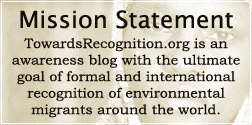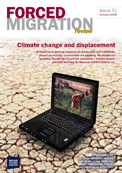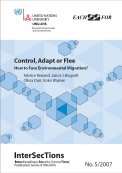Over the past few weeks, climate migration as exaggeration has been a popular refrain. Most notably, in a recently published article in Environment and Urbanization, where Dr. Cecilia Tacoli, senior researcher at the International Institute of Environment and Development, further makes the case that climate-induced migration projections are wildly inflated. Why, you ask yourself, would a pro-recognition organization analyze and disseminate an article that so flies in the face of its mission? The answer is simple: we are after facts. Facts that lead to real progress. And, in this regard, Dr. Tacoli forces us to acknowledge that “there is a real risk that alarmism will divert attention from real problems, resulting in policies that fail to protect the most vulnerable people.”
Dr. Tacoli is also of the growing chorus of analysts who cite migration as adaptation rather than as negative consequence. Ultimately, she says, “the failure to recognise the role of voluntary migration in adapting to climate change contributes to crisis-driven movements that inevitably increase the vulnerability of those forced to leave their homes and assets as they flee conflict and disaster…It is worth remembering that supporting migrants can ultimately help reduce the numbers of refugees.”
Below is a complete summary of Dr. Tacoli’s views for the BBC’s The Green Room in an article entitled “Climate migration fears ‘misplaced”.
(BBC News) September 29, 2009 – Fears of millions of “climate refugees” crossing national borders are not supported by evidence on the ground, says Cecilia Tacoli. In this week’s Green Room, she says we will fail to protect the world’s most vulnerable people if misconceptions about migration continue to shape policies. Search the internet for “migration” and “climate change” and you will find repeated warnings of a crisis in the making; of hundreds of millions of people on the move, of countries straining to cope with the pressure on their borders, and of national security under threat.
But these fears are based on many misconceptions about the duration, destination and composition of migrant flows.
There is a real risk that alarmism will divert attention from real problems, resulting in policies that fail to protect the most vulnerable people.
The longer it takes people to realise this, the bigger the true problems will become.
Firstly, the numbers of people likely to be moving have been exaggerated. Secondly, the notion commonly expressed in rich countries – that large numbers of poor people from across the planet will attempt to migrate there permanently – is clearly wrong.
Yes, hundreds of millions of people live in places that are highly vulnerable to climate change.
They face extreme weather conditions such as droughts and floods, or they live in low-lying coastal areas that are threatened by rising sea levels. Their lives and livelihoods are threatened in new and significant ways.
But this does not mean they will all migrate.
The poorest and most vulnerable people will often find it impossible to move, as they lack the necessary funds and social support. Those who can migrate will be more likely to make short-term, short-distance movements than permanent long-term ones.
Overall, long-distance international migration will be the least likely option.
Past lessons
What can we learn from the past? In northern Mali, the drought of 1983-5 affected local migration patterns, with an increase in temporary and short-distance movement and a decrease in long-term, intercontinental movement.
Similarly, recent research in Burkina Faso suggests that a decrease in rainfall increases temporary rural-rural migration.
On the other hand, migration to urban centres and to other nations, which entails higher costs, is more likely to take place after normal rainfall periods.
It is influenced by migrants’ education, the existence of social networks and access to transport and road networks.
In all cases, migrants make substantial contributions to the livelihoods of their relatives and communities, by sending money, information and goods back home.
A surprisingly large proportion of the income of rural people in Africa, Asia and Latin America comes from non-farm activities, and much of it as migrants’ remittances.
With climate change making farming more difficult, the need for these resources will increase.
Unfortunately, most governments and international agencies tend to see migration as a problem that needs to be controlled instead of a key part of the solution.
In doing so, they are missing opportunities to develop policies that can increase people’s resilience to climate change.
Room for new views
Policymakers must radically alter their views of migration, and see it as a vital adaptation to climate change rather than as an unwanted consequence or a failure to adapt.
This means that poorer nations need to prepare for climate change at home by building up infrastructure and basic services in small towns located in rural areas that could become destination hubs for local migrants.
Options include policies that promote access to non-farm jobs in small rural towns and a more decentralised distribution of economic opportunities.
To do so, they should first of all focus on increasing the capacity of local governments and institutions in small towns to support local economic development, provide basic services and regulate equitable access to natural resources.
Richer countries, meanwhile, need to stop panicking about a mass influx of migrants that is unlikely to happen and instead focus on helping the poorer countries to face climate change.
As the richer countries have emitted most of the greenhouse gases that cause climate change, they have a duty to address the problem.
This means providing poorer nations with financial support to help them adapt to climate change, which can either reduce the need for migration or enable it to proceed in a way that is sound and sustainable.
It also means taking
drastic domestic action to reduce the emissions of greenhouse gases that are causing climate change in the first place.
People are talking about migration as if it were something new, but people have always used their mobility as a means to protect themselves and escape from poverty.
The problem is not that people want to move, but that many of the most vulnerable people do not have the resources or livelihood options that will enable them to do so in a way that maintains their security.
Ironically, the failure to recognise the role of voluntary migration in adapting to climate change contributes to crisis-driven movements that inevitably increase the vulnerability of those forced to leave their homes and assets as they flee conflict and disaster.
It is worth remembering viagra discount that supporting migrants can ultimately help reduce the numbers of refugees.
Source: BBC News




According to Myers “These [numbers] should not be taken to be gospel truth…Rather they are informed estimates. If scientists kept quiet about numbers, then policymakers would say the absence of evidence [means] the absence of a problem.”
very true. people need to see the numbers before even thinking about taking any action !